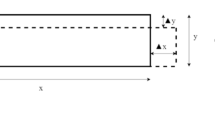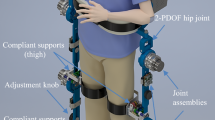Abstract
As the primary equipment for balance function assessment, the six-dimensional force platform (SDFP) should maintain its quality for long term use. Unfortunately the inevitable cross-talk will deteriorate its comprehensive performance. Obtaininga new sensitivity coefficient matrix through re-calibration is an effective way to guarantee the measurement accuracy. Generalized force loading can be used for in-situ calibration, but the calibration result depends on the selected set of loading point when the components are nonlinearly coupled.This study attempts to find an appropriate loading point set to obtain the optimal decoupling matrix for the SDFP when non-linearcoupling exists. The decoupling design of strain gauge layout and the non-linear coupling resulting from the bending deformation of the top plate are analyzed. Based on the analysis, a digital simulation is conducted to investigate the relationship between the decoupling performance and the selection of the loading points. The simulation results show that the center distance of the loading point is the primary factor affecting the decoupling performance. An in-situ calibration is conducted, and the orthogonal test rule is used to evaluate the performance of the system. A comparison of the results shows that the experimental results agree with those of the simulations.
Similar content being viewed by others
References
Veltink, P. H., Liedtke, C., Droog, E., and van der Kooij, H., “Ambulatory Measurement of Ground Reaction Forces,” IEEE Transactions on Neural Systems and Rehabilitation Engineering, Vol. 13, No. 3, pp. 423–427, 2005.
McCaw, S. T. and DeVita, P., “Errors in Alignment of Center of Pressure and Foot Coordinates Affect Predicted Lower Extremity Torques,” Journal of Biomechanics, Vol. 28, No. 8, pp. 985–988, 1995.
Kim, J., Kwon, Y., Eom, G.-M., Jun, J.-H., Lee, J.-W., and Tack, G.-R., “Effects of Vision, Age and Gender on Structural and Global Posturographic Features during Quiet Standing,” Int. J. Precis. Eng. Manuf., Vol. 13, No. 6, pp. 969–975, 2012.
Psycharakis, S. G. and Miller, S., “Estimation of Errors in Force Platform Data,” Research Quarterly for Exercise and Sport, Vol. 77, No. 4, pp. 514–518, 2006.
Cappello, A., Bagal, F., Cedraro, A., and Chiari, L., “Non-Linear Re-Calibration of Force Platforms,” Gait & Posture, Vol. 33, No. 4, pp. 724–726, 2011.
Cedraro, A., Cappello, A., and Chiari, L., “A Portable System for In-Situ Re-Calibration of Force Platforms: Theoretical Validation,” Gait & posture, Vol. 28, No. 3, pp. 488–494, 2008.
Liu, T., Inoue, Y., and Shibata, K., “Wearable Force Sensor with Parallel Structure for Measurement of Ground-Reaction Force,” Measurement, Vol. 40, No. 6, pp. 644–653, 2007.
Fei, S. and Cheng, W. Z., “A Calibration Method for Six Dimensional Force Sensor Calibration Device,” CN Patent. No. CN200810020511.4, 2008.
Hall, M., Fleming, H., Dolan, M., Millbank, S., and Paul, J., “Static in Situ Calibration of Force Plates,” Journal of Biomechanics, Vol. 29, No. 5, pp. 659–665, 1996.
Schmiedmayer, H.-B. and Kastner, J., “Parameters Influencing the Accuracy of the Point of Force Application Determined with Piezoelectric Force Plates,” Journal of Biomechanics, Vol. 32, No. 11, pp. 1237–1242, 1999.
Schmiedmayer, H.-B. and Kastner, J., “Enhancements in the Accuracy of the Center of Pressure (COP) Determined with Piezoelectric Force Plates are Dependent on the Load Distribution,” Journal of Biomechanical Engineering, Vol. 122, No. 5, pp. 523–527, 2000.
Chockalingam, N., Giakas, G., and Iossifidou, A., “Do Strain Gauge Force Platforms Need in Situ Correction?” Gait & Posture, Vol. 16, No. 3, pp. 233–237, 2002.
Tang, Y., Ge, Y., and Gao, L, “A New Design of Six Axes Force Measuring Table based on Holistic Structure and the Study of Its Dynamic Characteristic,” Chinese Journal of Scientific Instrument, Vol. 24, pp. 536–539, 2003.
Collins, S. H., Adamczyk, P. G., Ferris, D. P., and Kuo, A. D., “A Simple Method for Calibrating Force Plates and Force Treadmills using an Instrumented Pole,” Gait & Posture, Vol. 29, No. 1, pp. 59–64, 2009.
Rabuffetti, M., Ferrarin, M., Mazzoleni, P., Benvenuti, F., and Pedotti, A., “Optimised Procedure for the Calibration of the Force Platform Location,” Gait & Posture, Vol. 17, No. 1, pp. 75–80, 2003.
Li, H.-B., Sui, C.-P., Wang, H.-G., Gao, L.-F., Zhao, M.-Y., and Gong, H.-l., “New Calibration Method of Six-Axis Force Sensor based on Stewart Platform,” Chinese Journal of Sensors and Actuators, Vol. 19, No. 1, pp. 132–136, 2006.
Ma, Y., Zhang, Y., and Kennedy, D., “A Symplectic Analytical Wave based Method for the Wave Propagation and Steady State Forced Vibration of Rectangular Thin Plates,” Journal of Sound and Vibration, Vol. 339, pp. 196–214, 2015.
Wang, X., Wang, X., and Shi, X., “Accurate Buckling Loads of Thin Rectangular Plates under Parabolic Edge Compressions by the Differential Quadrature Method,” International Journal of Mechanical Sciences, Vol. 49, No. 4, pp. 447–453, 2007.
Clough, R. W. and Tocher, J. L., “Finite Element Stiffness Matrices for Analysis of Plates in Bending,” Proc. of Conference on Matrix Methods on Structural Analysis, pp. 515–545, 1965.
Zienkiewicz, O. C. and Taylor, R. L., “The Finite Element Method: Solid Mechanics,” Butterworth-Heinemann, 2000.
Chen, Y., Zhang, J., Yang, C., and Niu, B., “The Workspace Mapping with Deficient-DOF Space for the Puma 560 Robot and Its Exoskeleton Arm by using Orthogonal Experiment Design Method,” Robotics and Computer-Integrated Manufacturing, Vol. 23, No. 4, pp. 478–487, 2007.
Chan, K. Y., Kwong, C. K., and Luo, X. G., “Improved Orthogonal Array based Simulated Annealing for Design Optimization,” Expert Systems with Applications, Vol. 36, No. 4, pp. 7379–7389, 2009.
Author information
Authors and Affiliations
Corresponding author
Rights and permissions
About this article
Cite this article
Mao, Z., Cai, P., Wang, D. et al. Approach for decoupling the non-linear cross-talk in a six-dimensional force platform. Int. J. Precis. Eng. Manuf. 17, 303–308 (2016). https://doi.org/10.1007/s12541-016-0038-4
Received:
Revised:
Accepted:
Published:
Issue Date:
DOI: https://doi.org/10.1007/s12541-016-0038-4




